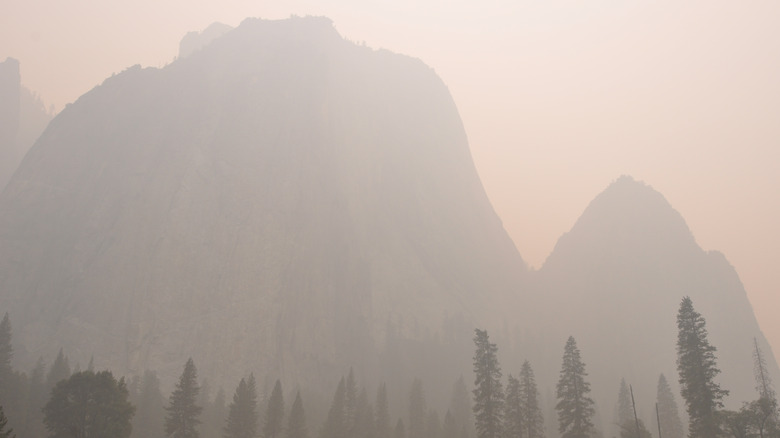The Top 4 National Parks With The Worst Air Quality Are All In The Same State
When you think of America's magnificent national parks, the gorgeous designated lands chosen to preserve some of the most precious natural resources in the country, you probably think of the most brilliant night skies, the most epic panoramic views, the purest waters, the most untouched forests, and — you'd think and hope — the cleanest air. Unfortunately, air quality in national parks is markedly declining, according to the alarming Polluted Parks Report released by the National Parks Conservation Association in March 2024. As stated in the NPCA report, "97% of national parks suffer from significant or unsatisfactory levels of harm from air pollution." In fact, as adverse and terrible as it is, air quality in these preserved and protected lands is often worse than in areas that have no designated preservation at all in America.
It happens that the four national parks at the top of this risk list are all found in California. Sequoia & Kings Canyon National Parks (two separate parks managed as one unit) have the worst air quality, with Joshua Tree National Park in Southern California coming in second and Mojave National Preserve and Yosemite National Park following third and fourth. Sadly, the air pollution rates of these California parks are so high that the Sequoia & Kings Canyon National Parks Case Study(also by the NPCA) classifies the air as straight-up unhealthy to breathe, borderline dangerous for those with prevalent respiratory conditions like asthma.
Alarming air pollution levels in these California national parks
And what is the cause for such an alarming decline in air quality in these four national parks? The NPCA's case study of Sequoia & Kings Canyon National Parks attributed the cause to the massive oil and gas industry footprint in California's Central Valley. In 2018 alone, the air at Sequoia was rated as unhealthy to breathe for two months, and the NPCA's Oil and Gas Report stated that Sequoia was one of the national parks most threatened by the gas and oil industry. One of the nation's largest oil fields lies in Bakersfield, and a current proposal to extend oil and gas development to an additional 1.2 million acres across the state highlights the fact that as bad as air quality is already, there is no projected stop or slow to this trajectory.
The second-worst air quality is at Joshua Tree, with many saying that "the air is as bad as in L.A." The boom in urban development and power plants in nearby Coachella Valley — as well as its proximity to the gigantic L.A. megalopolis — all contribute to poor air quality in this otherwise incredible park. Mojave and Yosemite have similar horror stories of air pollution drifting from California's most densely populated areas. Federal ozone restrictions are continually violated in California, leading to a lawsuit in 2018 against the Environmental Protection Agency. The lawsuit was led and won by the NPCA in an effort to make the EPA strictly enforce state pollution laws. The NPCA calls for change and strives to "alert decision-makers of environmental damage and apply pressure to the EPA,"
Calling for environmental change to protect our national parks
The NPCA is still taking great strides to raise awareness of this growing issue because air pollution has a far-reaching effect. It not only impacts visitors' health; more significantly, it trickles into widespread toxic interference with the basic biological functions of the parks' ecosystems and biodiversity.
The biggest contributor to dangerous air pollution in the parks is ozone, a criminal we're sure you've heard of, but one defined by the California Air Resources Board to be a "highly reactive and unstable gas capable of damaging living cells. This pollutant forms in the atmosphere through complex reactions between chemicals directly emitted from vehicles, industrial plants, consumer products, and many other sources." The Air Quality Index in these four California parks is often in the red, over the unhealthy-to-breathe marker. Kind of takes away from the magic of the Land of Giants if you remember that you're breathing in toxins, doesn't it?
Several other concerning statistics to note in the same NPCA report include that 96% of national parks have sensitive species and natural habitats harmed by sulfur and nitrogen deposition and ozone pollution, and that same 96% face ozone pollution problems that negatively affect human health. 387 out of 399 national parks were found to have unsatisfactory levels of haze in the skies. In other words, this is serious. We have much to do in order to protect our lands and air, but the first step towards change is awareness. Increasing individual awareness of your own footprint when exploring national parks will help the overall health and longevity of these beloved natural resources.


